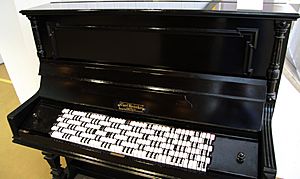Janko keyboard facts for kids
The Jankó keyboard is a special kind of musical keyboard made for pianos. It was invented by a man named Paul von Jankó in 1882. This keyboard looks different from a regular piano keyboard because it has six rows of keys instead of just one.
Contents
What Makes It Special?
The Jankó keyboard is known as a "6-plus-6-keyboard." This means it has six rows of keys, and they are arranged in a way that makes playing music easier for some people.
Easy Fingering
One of the best things about the Jankó keyboard is that you can use the same finger patterns for all musical scales. On a regular piano, you have to learn different finger patterns for different scales. But with the Jankó keyboard, once you learn one pattern, you can use it for any scale! This can make learning music simpler.
More Keys, More Options
A standard piano has 88 keys. On a Jankó keyboard designed for 88 notes, there would be 264 keys in total! Each musical note can be played by pressing three different keys that are lined up vertically. This gives musicians more ways to play notes and chords. The keys are connected inside, so pressing any of the three keys for a note will play that note.
A Special Place for Your Thumb
The design of the Jankó keyboard also gives your thumb its own special rows. This helps your hand move more smoothly across the keyboard, which can make playing faster and more comfortable.
Modern Use
Even though it was invented a long time ago, the Jankó keyboard design is still used today. For example, it's used in a modern electronic keyboard called the Chromatone 312. This shows that Paul von Jankó's idea was ahead of its time!
See also
 You can also find information about the Jankó keyboard for kids in Spanish: Teclado Jankó para niños
You can also find information about the Jankó keyboard for kids in Spanish: Teclado Jankó para niños


